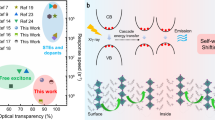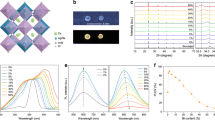Abstract
Recently, metal halide perovskites have received great attention for detecting ionizing radiation. Perovskite-based photodetectors and scintillators have been successfully implemented for X-ray and γ-ray detection due to their high attenuation coefficient and excellent optoelectronic properties. However, relatively thick absorbing layers are required for the complete absorption of X-ray photons, which are very challenging to fabricate with solution processes. In this work, we designed hybrid devices coupled with excellent perovskite photodiodes to utilize the incident X-rays fully. Considering the heavy reabsorption of the perovskite layers, we blended CsPbBr3 with a Cu(I)-containing thermally activated delayed fluorescent complex (MAC*)Cu(Cz) to achieve down-conversion luminescence effectively to maximize the radioluminescence quantum efficiency, and we also found a faster afterglow compared with the commercial scintillators. Furthermore, we systematically investigated the performance metrics of the CsPbIBr2 photodiodes and scintillator films. The hybrid devices demonstrated significantly improved X-rays sensitivity, indicating potential for X-ray detection and imaging.

摘要
金属卤化物钙钛矿材料具有极高的射线衰减系数和优良的光电 性能, 基于其制备的光电探测器和闪烁体已成功用于X射线和γ-射线探 测. 然而, 充分吸收高能射线需要相对较厚的光吸收层, 但所需的厚度 对于溶液法制备的钙钛矿薄膜来说很难达到. 在这项工作中, 我们设计 了一种复合型器件, 其不需要厚的钙钛矿吸收层, 而是利用高荧光效率 的钙钛矿闪烁体和性能优良的钙钛矿薄膜光电探测器充分吸收和利用 X射线, 从而提高X射线探测性能. 而考虑到钙钛矿闪烁体严重的自吸 收, 我们将CsPbBr3与含Cu(I)的热激活延迟荧光配合物(MAC*)Cu(Cz) 混合, 有效地实现了下转换发光, 最大限度地提高了辐射发光量子效率. 与商业闪烁体相比, 混合闪烁体还实现了更短的余辉. 此外, 我们系统 地研究对比了CsPbIBr2探测器以及复合型探测器的性能指标, 发现复 合型探测器对X射线的探测灵敏度有显著提高, 并且能够实现在X射线 下清晰的成像. 这项工作为提高X射线探测性能提供了一种新的思路, 在应用层面具有巨大的潜力.
Similar content being viewed by others
References
Szeles C. CdZnTe and CdTe materials for X-ray and gamma ray radiation detector applications. Phys Status Solidi B, 2004, 241: 783–790
Kim YC, Kim KH, Son DY, et al. Printable organometallic perovskite enables large-area, low-dose X-ray imaging. Nature, 2017, 550: 87–91
Mengesha W, Taulbee TD, Rooney BD, et al. Light yield non-proportionality of CsI(Tl), CsI(Na), and YAP. IEEE Trans Nucl Sci, 1998, 45: 456–461
van Eijk CWE. Inorganic scintillators in medical imaging. Phys Med Biol, 2002, 47: R85–R106
Xu Y, Lin Q. Photodetectors based on solution-processable semiconductors: Recent advances and perspectives. Appl Phys Rev, 2020, 7: 011315
Turren-Cruz SH, Hagfeldt A, Saliba M. Methylammonium-free, high-performance, and stable perovskite solar cells on a planar architecture. Science, 2018, 362: 449–453
Saliba M, Correa-Baena JP, Grätzel M, et al. Perovskite solar cells: From the atomic level to film quality and device performance. Angew Chem Int Ed, 2018, 57: 2554–2569
Li C, Guerrero A, Zhong Y, et al. Real-time observation of iodide ion migration in methylammonium lead halide perovskites. Small, 2017, 13: 1701711
Li C, Guerrero A, Huettner S, et al. Unravelling the role of vacancies in lead halide perovskite through electrical switching of photoluminescence. Nat Commun, 2018, 9: 5113
Chen Q, Wu J, Ou X, et al. All-inorganic perovskite nanocrystal scintillators. Nature, 2018, 561: 88–93
Cao J, Guo Z, Zhu S, et al. Preparation of lead-free two-dimensional-layered (C8H17NH3)2SnBr4 perovskite scintillators and their application in X-ray imaging. ACS Appl Mater Interfaces, 2020, 12: 19797–19804
Wei H, Huang J. Halide lead perovskites for ionizing radiation detection. Nat Commun, 2019, 10: 1066
Mykhaylyk VB, Kraus H, Saliba M. Bright and fast scintillation of organolead perovskite MAPbBr3 at low temperatures. Mater Horiz, 2019, 6: 1740–1747
Li W, Li H, Song J, et al. Fine-control-valve of halide perovskite single crystal quality for high performance X-ray detection. Sci Bull, 2021, 66: 2199–2206
Wang X, Shi H, Ma H, et al. Organic phosphors with bright triplet excitons for efficient X-ray-excited luminescence. Nat Photonics, 2021, 15: 187–192
Shrestha S, Fischer R, Matt GJ, et al. High-performance direct conversion X-ray detectors based on sintered hybrid lead triiodide perovskite wafers. Nat Photon, 2017, 11: 436–440
Yakunin S, Sytnyk M, Kriegner D, et al. Detection of X-ray photons by solution-processed lead halide perovskites. Nat Photon, 2015, 9: 444–449
Daum M, Deumel S, Sytnyk M, et al. Self-healing Cs3Bi2Br3I6 perovskite wafers for X-ray detection. Adv Funct Mater, 2021, 31: 2102713
Zhao J, Zhao L, Deng Y, et al. Perovskite-filled membranes for flexible and large-area direct-conversion X-ray detector arrays. Nat Photonics, 2020, 14: 612–617
Qian W, Xu X, Wang J, et al. An aerosol-liquid-solid process for the general synthesis of halide perovskite thick films for direct-conversion X-ray detectors. Matter, 2021, 4: 942–954
Moseley ODI, Doherty TAS, Parmee R, et al. Halide perovskites scintillators: Unique promise and current limitations. J Mater Chem C, 2021, 9: 11588–11604
Zhu W, Ma W, Su Y, et al. Low-dose real-time X-ray imaging with nontoxic double perovskite scintillators. Light Sci Appl, 2020, 9: 112
Heo JH, Shin DH, Park JK, et al. High-performance next-generation perovskite nanocrystal scintillator for nondestructive X-ray imaging. Adv Mater, 2018, 30: 1801743
Yang B, Yin L, Niu G, et al. Lead-free halide Rb2CuBr3 as sensitive X-ray scintillator. Adv Mater, 2019, 31: 1904711
Gandini M, Villa I, Beretta M, et al. Efficient, fast and reabsorption-free perovskite nanocrystal-based sensitized plastic scintillators. Nat Nanotechnol, 2020, 15: 462–468
Ma W, Su Y, Zhang Q, et al. Thermally activated delayed fluorescence (TADF) organic molecules for efficient X-ray scintillation and imaging. Nat Mater, 2022, 21: 210–216
Cao F, Yu D, Ma W, et al. Shining emitter in a stable host: Design of halide perovskite scintillators for X-ray imaging from commercial concept. ACS Nano, 2020, 14: 5183–5193
Ying A, Huang YH, Lu CH, et al. High-efficiency red electroluminescence based on a carbine-Cu(I)-acridine complex. ACS Appl Mater Interfaces, 2021, 13: 13478–13486
Hamze R, Shi S, Kapper SC, et al. “Quick-silver” from a systematic study of highly luminescent, two-coordinate, d10 coinage metal complexes. J Am Chem Soc, 2019, 141: 8616–8626
Crothers TW, Milot RL, Patel JB, et al. Photon reabsorption masks intrinsic bimolecular charge-carrier recombination in CH3NH3PbI3 perovskite. Nano Lett, 2017, 17: 5782–5789
Wang M, Wang K, Gao Y, et al. Impact of photoluminescence reabsorption in metal-halide perovskite solar cells. Sol RRL, 2021, 5: 2100029
Acknowledgements
This work was financially supported by the National Natural Science Foundation of China (61875154 and 52022071), the Natural Science Foundation of Jiangsu Province, China (BK20190214), the National Key R&D Program of China (2020YFB2008800), and China Postdoctoral Science Foundation (2021M702513).
Author information
Authors and Affiliations
Contributions
Xu Y and Ying A performed the experiments and cowrote the paper. Peng J and Yao F helped analyze the data and reviewed the paper. Li R and Tan Y helped the preparation and characterization of materials. Lin Q and Gong S supervised the study. All authors contributed to the general discussion.
Corresponding authors
Additional information
Conflict of interest
The authors declare that they have no conflict of interest.
Supplementary information
Experimental details and supporting data are available in the online version of the paper.
Yalun Xu received his bachelor’s degree in materials physics at Wuhan University in 2018. Since 2018, he has been a PhD student in the group of Prof. Qianqian Lin at the School of Physics and Technology, Wuhan University. His research interests include material characterization, semiconductor physics and opto-electronic materials.
Ao Ying is a PhD student at Hubei Key Lab on Organic and Polymeric Optoelectronic Materials, Wuhan University. His research focuses on the optoelectronic materials and devices, mainly in the design, synthesis, and photophysics of luminescent coinage-metal complexes.
Shaolong Gong received his PhD degree in materials physics and chemistry from Wuhan University in 2012. After the two-year postdoctoral study at the University of Toronto, he joined the faculty of Wuhan University as an associate professor in 2014 and was promoted to a full professor in 2020. His current research interests are centered on the molecular design and synthesis of new-generation organic emitters and luminescent coinage metal complexes for organic optoelectronic devices.
Qianqian Lin is currently a professor of materials physics at the School of Physics and Technology, Wuhan University. He received his PhD degree from The University of Queensland, Australia, in 2016. After a postdoctoral position at the Clarendon Laboratory, University of Oxford, UK, he joined Wuhan University in 2017. His research interests include characterizations of advanced functional materials, chalcogenides and perovskite/organic opto-electronic devices.
Rights and permissions
About this article
Cite this article
Xu, Y., Ying, A., Peng, J. et al. Hybrid perovskite X-ray detectors with enhanced radioluminescence via thermally activated delayed fluorescence. Sci. China Mater. 66, 724–732 (2023). https://doi.org/10.1007/s40843-022-2193-6
Received:
Accepted:
Published:
Issue Date:
DOI: https://doi.org/10.1007/s40843-022-2193-6




